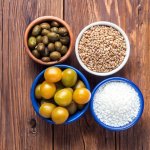GreekGirlCooks
Member
The holiday season is coming up and I know I will be eating decadently while out and about - but not every day. So, I am brainstorming ways I can eat healthy in between gatherings.
Greek Salad
Greek Salad is one of the healthiest typical Greek dishes you'll find. It's loaded with fresh veggies, including cucumbers, tomatoes, onions, and peppers, all chlorophyll-rich veggies. The addition of olive oil, olives, and feta cheese also makes the dish a healthy Mediterranean source of fat. Think of it as an antioxidant powerhouse.
Grilled Seafood
Greek cuisine is known for its grilled seafood, which is an excellent source of lean protein. When grilling seafood, the fats convert into healthy omega-3 fatty acids. When you combine it with veggies, like tomatoes and zucchini, seasoned with herbs and sprinkled with feta cheese, the flavor profile is heightened to delightful new heights.
Dolmades
Dolmades has herbs and rice with ground beef, and then wrapped in steamed grape leaves, making it one of the most delicious and healthy Greek dishes available. Grape leaves contain glucosinolates, which are anti-carcinogenic.
Spanakopita
This Spinach and Feta Pie is a pastry that is filled with spinach, feta cheese, and eggs, all inside a light and crispy filo pastry. Spinach is rich in folate, a nutrient that helps in healthy brain development, and feta cheese, providing you with calcium and protein.
Souvlaki
Grilled skewers of marinated meat and vegetables, Souvlaki, come in many different types, which include chicken, lamb, pork, and vegetables. Whether you are a vegetarian or non-vegetarian, this dish is filled with protein and cooked veggies, a perfect combination for a healthy meal.

Greek Salad
Greek Salad is one of the healthiest typical Greek dishes you'll find. It's loaded with fresh veggies, including cucumbers, tomatoes, onions, and peppers, all chlorophyll-rich veggies. The addition of olive oil, olives, and feta cheese also makes the dish a healthy Mediterranean source of fat. Think of it as an antioxidant powerhouse.
Grilled Seafood
Greek cuisine is known for its grilled seafood, which is an excellent source of lean protein. When grilling seafood, the fats convert into healthy omega-3 fatty acids. When you combine it with veggies, like tomatoes and zucchini, seasoned with herbs and sprinkled with feta cheese, the flavor profile is heightened to delightful new heights.
Dolmades
Dolmades has herbs and rice with ground beef, and then wrapped in steamed grape leaves, making it one of the most delicious and healthy Greek dishes available. Grape leaves contain glucosinolates, which are anti-carcinogenic.
Spanakopita
This Spinach and Feta Pie is a pastry that is filled with spinach, feta cheese, and eggs, all inside a light and crispy filo pastry. Spinach is rich in folate, a nutrient that helps in healthy brain development, and feta cheese, providing you with calcium and protein.
Souvlaki
Grilled skewers of marinated meat and vegetables, Souvlaki, come in many different types, which include chicken, lamb, pork, and vegetables. Whether you are a vegetarian or non-vegetarian, this dish is filled with protein and cooked veggies, a perfect combination for a healthy meal.




